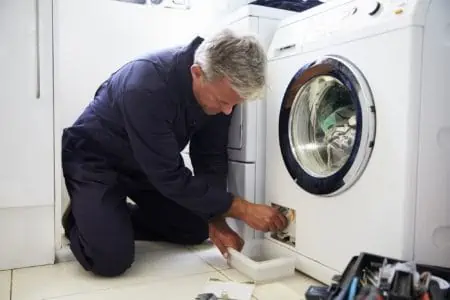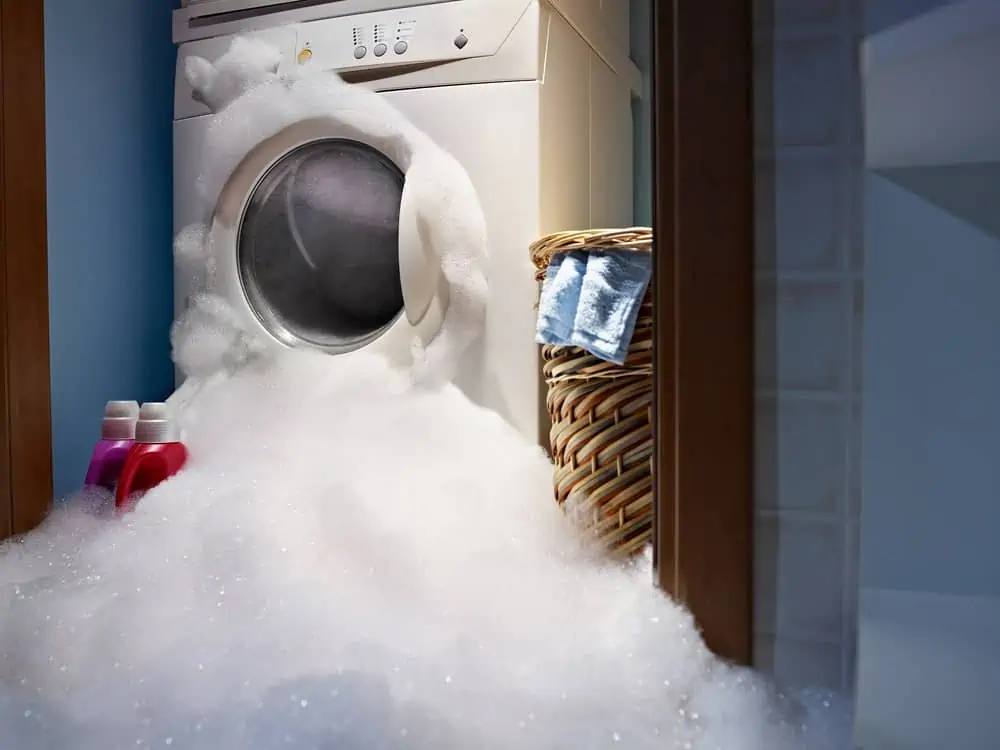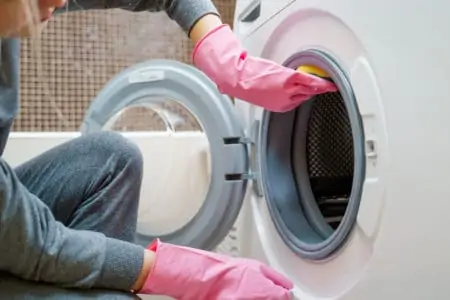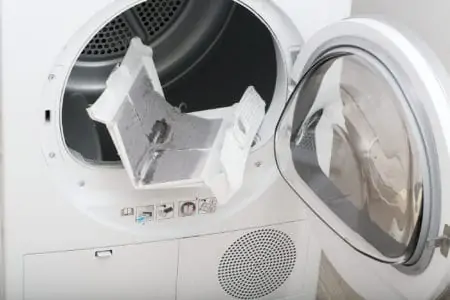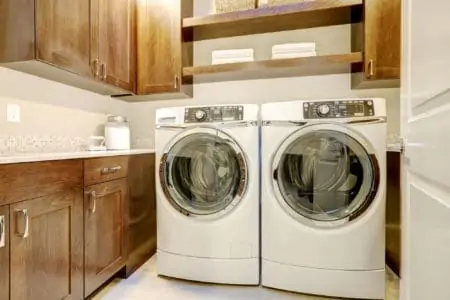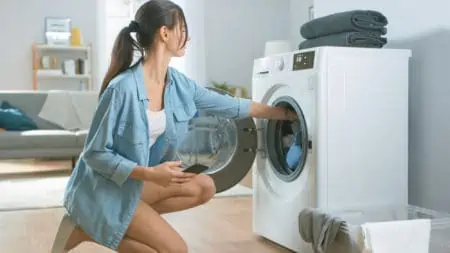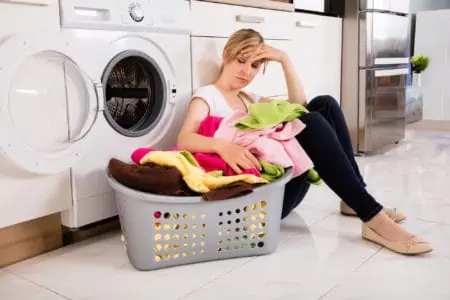Walking into your laundry room to discover a leaking washing machine is horrifying. You have a large puddle of water damaging the floor of your room. It’s a terrifying and potentially expensive experience.
Let’s help you establish why your washing machine may be leaking and how you may be able to fix it.
Key Takeaways
- A washing machine can leak due to damaged door seal, water intake hoses, or internal issues like water pump or internal hoses.
- For front load washers, leaking can also occur from a damaged outer drum or improper door alignment.
- To fix leaks, check and replace damaged parts, clean the water pump filter, balance the washing machine, and ensure proper usage of detergent.
- It’s worth fixing a leaking washing machine if the repair cost is low, but consider replacing it if the repair cost is more than 50% of the cost of a new machine.
Why Is My Washing Machine Leaking?
If you discover that your washing machine is leaking, you should first turn off your washing machine and unplug it. Make sure that it’s level and turn off the taps. Then begin checking for reasons why your washing machine may be leaking.
From Underneath the Washer
If you discover that your washing machine is leaking from the bottom, some potential causes could be the water pump, internal water hoses, or a leaking drum on a front load washing machine.
Water Pump
Sometimes the seals of your water pump may tear or break. To discover if this is the reason, you will need to access the water pump access panel. It should be located at the front of your washing machine near the floor.
Grab some old towels or a tray to catch the water and place them underneath the pump access panel. Then open the panel and unscrew the larger pump filter.
Pull the filter and clear away any debris inside of it. Look for possible leaks in the pump casing. If you discover any leaks, you will need to replace the pump casing or have someone repair it.
Internal Water Hoses
Water hoses inside your washing machine can also become damaged or disconnected causing your washer to start leaking from the bottom. You will need to open your washing machine to inspect the internal hoses and components. If you’re unsure of how to do so, it’s advised that you call a professional.
Front Load Washer Drum
A front load washing machine has inner and outer drums. The outer drum is often manufactured in two pieces and bolted together. These seams can begin to leak and may need to be replaced or repaired.
From Front of Washer
There are several reasons why a washing machine may be dripping water from the front or from the top of the washer, but these reasons vary if you have a front load or top loading machine.
Top Load Washers
There are several reasons why a top load washing machine may be leaking from the front of the machine. For instance, you may have excessive suds from using too much detergent in your machine.
Leaking may also be caused by an overloaded or off-balance washing machine. Make sure your washer is level, reduce the size of the loads you wash, and keep an eye out for more leaking.
If the leaking is happening in the spin cycle, you could have a loose or damaged tub cover gasket. This allows the water to be thrown out of the top as the washing machine spins.
Another reason for leaking is if you manually advance the time which can cause problems with the spray rinse function. The spray rinse may go too long causing the washing machine to overflow.
One last reason for a top load washing machine to overflow is if you have a malfunctioning water level switch. The switch doesn’t stop the inflow of water, so the tub overflows and leaks.
Front Load Washing Machines
A front load washer may stop leaking from the front if the door is not closing properly. Try loosening and readjusting the hinges to make sure the alignment is correct.
Also, look to see if the door seal is dirty or damaged. If it’s not kept clean and free of soil and soap, then the seal will leak. The solution is to clean the gasket weekly.
Another reason is the door may not be closing properly – try loosening and readjusting the hinges to make sure that the alignment is right
From Back of Washer
If your washing machine is leaking from the back of the washing machine, you will need to check the drain plug, drain hose, and intake hoses to discover the cause.
Drain Plug
Manufacturers put a drain plug over the drain and sometimes the plug is not removed before installing the drain hose. You will need to remove the drain hose and find the plastic plug. Then remove the plug and discard it.
Drain Hose
The drain hose at the back of the machine can sometimes become blocked, damaged, or disconnected. You will notice the leak during the drain cycle.
So carefully inspect the drain hose to make sure it’s properly secured in the drainpipe and the drainpipe isn’t clogged causing your washing machine to leak from the drain hose.
Water Supply Valves or Hoses
Leaks from water supply valves or hoses may also occur when your washer is not in use or during fill. The first step is to check to see if the intake hoses are punctured, bent, clogged, or rusted. Ensure that the connections are secure at the fill hoses and that you’re using rubber washers to prevent leaks.
You need to make sure that everything is secure and watertight. Replace any damaged hoses.
Front Load Washer
Front load washing machines may leak in the back if there are too many suds in the washing machine. Make sure that you always only use a small amount of HE detergent to prevent excessive suds.
How to Fix a Leaking Washing Machine
If your washing machine is leaking, you can try unclogging the water pump filter or balancing your machine.
Clogged Water Pump Filter
A water pump filter needs to be cleaned every three months to prevent it from becoming clogged and leaking.
1. Open Access Panel
You will need to open the access panel on the washing machine. It is usually located on the bottom of the front panel.
2. Drain Hose and Unscrew Pump Filter
If you see a small drain hose, begin by disconnecting the hose and allowing it to drain into a tray or small bowl.
Unscrew the pump filter so that you can remove it from the washing machine. Make sure that you have some old towels, a tray, or a small bowl underneath the filter to catch any water that may drain from it.
3. Clean Filter
Clean out any loose hair, dirt, and foreign objects you find in the pump filter and hose. Carefully check for clogs and remove any that you find.
4. Rinse Filter
Rinse the pump filter under running water. Then inspect the filter for any foreign objects, dirt, or hair that you may have left behind.
5. Wipe Clean
Wipe the pump filter and the cavity clean with a damp cloth.
6. Replace Filter
Replace the pump filter by screwing it back into place and making sure that any drain hoses are reconnected. Finish by closing the access panel.
Balance Washing Machine
Make sure that your washing machine is balanced to prevent it from leaking. The first step is to make sure that you’re not washing loads that are too large for your washing machine to handle or too heavy items in your machine.
If that doesn’t balance your washing machine, check to make sure that the feet are level. You can also create a level platform for your washing machine to sit on using ⅝ inch plywood.
Replace Intake Hoses
Replace any damaged, rusted, or broken intake hoses. Purchase replacement intake hoses at your local hardware store. Disconnect the old hoses from the intake valves and the washing machine making sure that you keep track of the hot and cold connectors.
Attach the new hoses to the intake valves and washing machine. Make sure that you use the hot water hose on the hot water connectors and the cold water hose on the cold water connectors. Check that nothing leaks as you slowly turn on the water.
Is It Worth Fixing a Leaking Washing Machine?
Many leaks are cheap and easy to fix or replace yourself such as damaged intake hoses or a door seal. You can also clear a blocked pump filter as well.
Consider replacing your washing machine if your machine is older, the repairs will be more than 50% of the cost of a new machine, or the drum is leaking.
FAQs
Why Is My Washer Leaking
Nothing is worse than discovering that your Samsung, Whirlpool, or Maytag washing machine is leaking. Thankfully, many of the causes of a washer leaking such as a clogged drain hose, damaged intake hoses, or a damaged door seal are simple and easy to repair.
